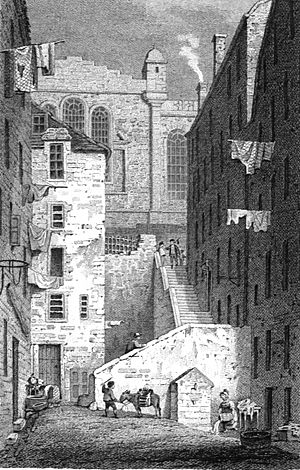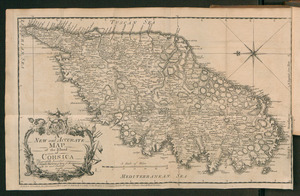James Boswell facts for kids
Quick facts for kids
James Boswell
|
|
|---|---|
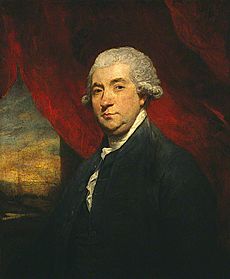
Portrait by Sir Joshua Reynolds, 1785
|
|
| Born | 29 October 1740 (N.S.) Edinburgh, Scotland |
| Died | 19 May 1795 (aged 54) London, England |
| Occupation | Lawyer, diarist, biographer |
| Language | English |
| Nationality | Scottish |
| Citizenship | Great Britain |
| Alma mater | |
| Notable works | Life of Johnson |
| Spouse | |
| Children |
|
James Boswell (born October 29, 1740 – died May 19, 1795) was a Scottish writer, diarist, and lawyer from Edinburgh. He is most famous for writing the biography of his friend, the English writer Samuel Johnson. Many people say this book, called Life of Johnson, is the best biography ever written in English.
Over the years, many of Boswell's personal diaries, letters, and papers have been found. These writings have helped people learn much more about his life and work.
Contents
Early Life and Education
James Boswell was born in Edinburgh, Scotland, on October 29, 1740. He was the oldest son of Alexander Boswell, Lord Auchinleck, who was a judge. His mother was Euphemia Erskine. As the oldest son, James was set to inherit his family's estate in Auchinleck, Ayrshire.
When he was five, James went to James Mundell's academy, a school where he learned English, Latin, writing, and math. He was not happy there and felt very shy. So, he was taught by private tutors at home instead. One of his tutors, John Dunn, introduced him to interesting books like The Spectator essays.
At thirteen, Boswell started studying at the University of Edinburgh from 1753 to 1758. During this time, he sometimes struggled with his mood, but he always recovered. He was described as having dark hair and eyes, and being of average height.
At nineteen, he continued his studies at the University of Glasgow, where he attended lectures by Adam Smith. After passing his law exam in 1762, he was allowed to go to London. There, on May 16, 1763, he met Samuel Johnson for the first time. They quickly became good friends, and Johnson even gave Boswell the nickname "Bozzy."
Their first conversation was quite famous:
- Boswell said: "Mr Johnson, I do indeed come from Scotland, but I cannot help it."
- Johnson replied: "That, Sir, I find, is what a very great many of your countrymen cannot help."
Travels in Europe
A few months after meeting Johnson, Boswell traveled to Europe. His first goal was to continue his law studies at Utrecht University in the Netherlands. He spent a year there and, after some initial unhappiness, he enjoyed his time. He became friends with Isabelle de Charrière, a smart young Dutchwoman.
After Utrecht, Boswell spent nearly two years traveling around Europe on what was called a "Grand Tour." He met famous thinkers like Jean-Jacques Rousseau and Voltaire. He also visited Rome, where his portrait was painted. Boswell even went to Corsica to meet Pasquale Paoli, a leader fighting for Corsican independence. His detailed diaries and letters from this time have been published in books like Boswell in Holland and Boswell on the Grand Tour.
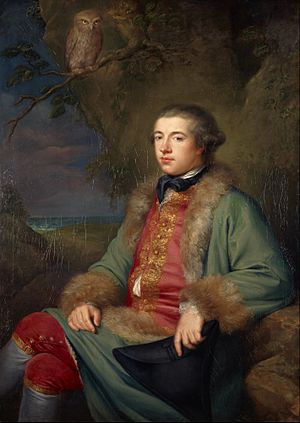
Life as a Lawyer and Writer
Boswell returned to London in 1766 and then moved back to Scotland. He finished his law studies at Edinburgh University and became a lawyer. He worked as a lawyer for more than ten years. Even though he lived in Scotland, he visited London every year to spend time with Samuel Johnson and other writers. He enjoyed these trips as a break from his everyday life in Scotland.
Boswell strongly supported the Corsican Republic. When France invaded Corsica in 1768, he tried to get people to help the Corsicans. He even sent them weapons and money, but the Corsicans were defeated in 1769. Boswell also supported the American Revolution, which his friend Johnson did not agree with.
On November 25, 1769, Boswell married his cousin, Margaret Montgomerie. They had four sons and three daughters. Two of their sons died when they were babies. Their other children were Alexander, James, Veronica, Euphemia, and Elizabeth.
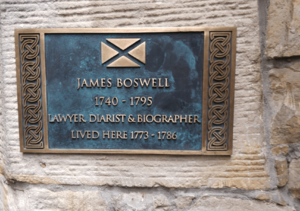
Even though he wrote popular books about his travels, Boswell was only a moderately successful lawyer. He lived in David Hume's old house in James Court from 1773 to 1786.
Later Years and Legacy
After Samuel Johnson died in 1784, Boswell moved to London. He tried to work as a lawyer there, but he was not very successful. He spent his final years writing his most famous book, Life of Samuel Johnson.
During this time, his health began to get worse. James Boswell died in London in 1795. He was buried in the family tomb in the old Auchinleck Kirkyard in Ayrshire, Scotland.
The Life of Samuel Johnson
When Life of Samuel Johnson was published in 1791, it was very unique. Unlike other biographies of that time, Boswell included actual conversations he had written down in his journals. He also shared more personal details about Johnson, making the book feel very real and intimate.
People like Macaulay and Carlyle wondered how Boswell could write such a detailed book. They thought that Boswell's honesty and ability to observe people closely helped him create such a great work.
Views on Slavery
James Boswell was at a meeting in May 1787 for the Society for Effecting the Abolition of the Slave Trade. This group wanted to end the slave trade. However, by 1788, Boswell changed his mind and became against the abolition movement.
In 1791, he wrote a poem called "No Abolition of Slavery; or the Universal Empire of Love." In this poem, he made fun of people who wanted to end slavery. He also suggested that enslaved people were happy with their lives, which was a common argument used by those who supported slavery at the time.
Major Works
- The Cub at Newmarket (1762)
- Letters Between the Honourable Andrew Erskine, and James Boswell, Esq. (1763)
- Dorando, a Spanish Tale (1767)
- An Account of Corsica, The Journal of a Tour to That Island, and Memoirs of Pascal Paoli (1768)
- "The Rampager" (1770–82, a series of essays)
- The Hypochondriack (1777–83, a series of essays)
- The Journal of a Tour to the Hebrides with Samuel Johnson, LL.D (1785)
- The Life of Samuel Johnson, LL.D (1791)
- No Abolition of Slavery (1791, a poem)
|
See also
 In Spanish: James Boswell para niños
In Spanish: James Boswell para niños


